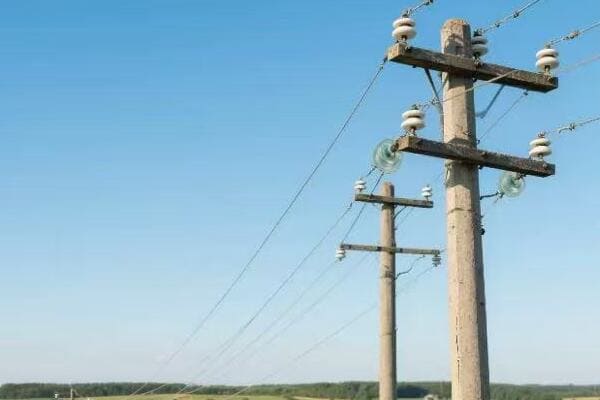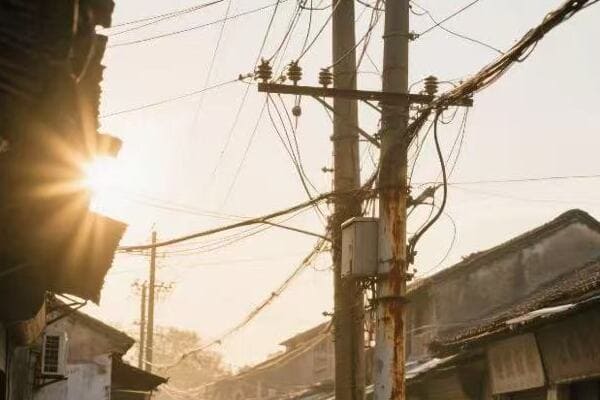How Transformers Are Integrated into Overhead Power Lines: A Step-by-Step Overview?
Have you ever looked up at power lines and wondered how electricity gets from those high-voltage wires to your home? The secret lies in transformers, but how exactly are they integrated into the power line system?
Transformers are integrated into overhead power lines through a systematic process involving careful planning, strategic placement, and precise electrical connections. This process includes selecting appropriate pole locations, mounting the transformer securely, connecting it to high-voltage and low-voltage lines, installing protective devices like fuses and arresters, and implementing proper grounding. The integration ensures efficient voltage step-down for local distribution while maintaining system safety and reliability. Each step requires expert knowledge of electrical engineering and adherence to strict safety standards.

In this comprehensive guide, I’ll walk you through the step-by-step process of integrating transformers into overhead power lines. Whether you’re an engineering student, a utility professional, or simply curious about power distribution, this article will provide valuable insights into the crucial role transformers play in our electrical infrastructure.
Introduction: Why Transformers Are Critical to Power Line Systems?
Have you ever wondered why we can’t simply connect our homes directly to the high-voltage power lines running through our neighborhoods? The answer lies in the critical role of transformers, but what makes these devices so essential to our power distribution system?
Transformers are critical to power line systems because they enable efficient long-distance power transmission and safe local distribution. They step down high voltages (typically 11kV to 33kV) used for transmission to lower voltages (230V/400V) suitable for homes and businesses. This voltage transformation is crucial for minimizing power losses over long distances while ensuring safe voltage levels for end-users. Transformers also provide electrical isolation between primary and secondary circuits, enhancing system safety and allowing for flexible power distribution configurations.

Key Aspects of Transformer Importance in Power Systems
Let’s explore the main reasons why transformers are indispensable:
- Efficient Power Transmission
- Voltage Adaptation for End-Users
- System Flexibility and Control
- Safety and Isolation
- Power Quality Management
Efficient Power Transmission
Enabling long-distance power delivery:
- High voltage reduces current, minimizing line losses
- Transformers allow for voltage step-up at generation and step-down for distribution
- Crucial for connecting remote power plants to urban centers
I recently visited a large substation where massive transformers were stepping down voltage from 500kV transmission lines to 33kV for regional distribution. The sheer scale of these devices highlighted their vital role in efficient power transmission across vast distances.
Voltage Adaptation for End-Users
Making electricity usable for consumers:
- Step-down transformers reduce voltage to safe levels for homes and businesses
- Different voltage levels can be provided for various applications (residential vs. industrial)
- Allows standardization of consumer electrical equipment
During a recent residential development project, I saw firsthand how pole-mounted transformers stepped down 11kV line voltage to 230V for household use, making the power from high-voltage lines safely accessible to homeowners.
System Flexibility and Control
Enhancing grid management:
- Transformers with tap changers allow for voltage regulation
- Enable creation of substations and distribution points
- Facilitate interconnection of different power systems
Here’s a quick overview of transformer applications in system control:
| Application | Transformer Type | Purpose |
|---|---|---|
| Substation | Power Transformer | Bulk power transfer and voltage regulation |
| Distribution | Pole-mounted/Pad-mounted | Local voltage step-down and power distribution |
| Industrial | Specialized Transformers | Specific voltage levels for industrial processes |
Safety and Isolation
Protecting the grid and consumers:
- Electrical isolation between high-voltage and low-voltage systems
- Fault current limitation
- Grounding systems for safety
Power Quality Management
Maintaining reliable electricity supply:
- Harmonic mitigation through transformer design
- Voltage stabilization in distribution networks
- Power factor improvement in some specialized transformers
Key points about transformer criticality:
- Transformers enable efficient long-distance power transmission
- They provide safe voltage levels for end-users
- Transformers offer flexibility in power system design and operation
- They enhance safety through electrical isolation
- Transformers play a role in maintaining power quality
In my experience, the importance of transformers becomes most apparent during power system upgrades or expansions. I recall a project where we were extending power lines to a remote rural area. The strategic placement of step-down transformers along the line was crucial in maintaining voltage levels and minimizing losses, ultimately making electrification feasible for distant communities.
For example, in a recent smart grid project, we implemented advanced transformers with on-load tap changers and monitoring capabilities. These units not only provided the necessary voltage transformation but also contributed to real-time grid management, showcasing how modern transformers are evolving to meet the complex needs of today’s power systems.
As we move on to discuss the step-by-step process of integrating transformers into overhead power lines, keep in mind the critical functions these devices serve. Understanding their importance will help you appreciate the careful planning and execution required in their integration.
Step 1: Planning the Line Route and Load Demand?
Have you ever wondered how utility companies decide where to place power lines and transformers? The process starts long before any equipment is installed, with careful planning of the line route and assessment of load demand. But what factors are considered in this crucial first step?
Planning the line route and load demand is the foundational step in integrating transformers into overhead power lines. This process involves analyzing geographical features, existing infrastructure, and future development plans to determine the optimal path for power lines. Load demand assessment includes studying current electricity usage patterns, projecting future growth, and identifying peak demand periods. Factors like population density, industrial zones, and potential renewable energy integration are considered. This comprehensive planning ensures efficient power distribution, minimizes losses, and allows for strategic placement of transformers to meet both current and future energy needs.

Key Aspects of Line Route and Load Demand Planning
Let’s break down the main elements of this planning phase:
- Geographical and Environmental Analysis
- Load Demand Assessment
- Future Growth Projections
- Regulatory and Community Considerations
- Technical Feasibility Studies
Geographical and Environmental Analysis
Understanding the terrain and constraints:
- Topographical surveys to identify natural barriers and optimal paths
- Environmental impact assessments
- Consideration of existing infrastructure and rights-of-way
I recently participated in a route planning project where we used advanced GIS mapping to analyze potential line paths. The ability to overlay topographical data with satellite imagery and land use information was crucial in identifying the most efficient and least disruptive route.
Load Demand Assessment
Determining power needs:
- Analysis of current electricity consumption patterns
- Identification of major load centers (residential areas, industrial zones)
- Seasonal variations in power demand
During a recent urban expansion project, we conducted detailed load surveys of existing neighborhoods and projected new developments. This data was vital in sizing transformers and planning their distribution along the proposed line route.
Future Growth Projections
Planning for long-term needs:
- Population growth forecasts
- Economic development plans for the area
- Potential for renewable energy integration
Here’s a simplified view of how we factor in growth projections:
| Time Frame | Considerations | Impact on Planning |
|---|---|---|
| Short-term (1-5 years) | Approved development projects | Immediate capacity needs |
| Medium-term (5-10 years) | Zoning changes, economic trends | Phased transformer upgrades |
| Long-term (10+ years) | Regional development plans | Right-of-way acquisition, substation locations |
Regulatory and Community Considerations
Navigating legal and social aspects:
- Compliance with local, state, and federal regulations
- Community engagement and addressing public concerns
- Coordination with other utility services (water, gas, telecommunications)
Technical Feasibility Studies
Ensuring practical implementation:
- Engineering studies for line capacity and voltage drop calculations
- Transformer placement optimization for efficient power distribution
- Integration with existing power infrastructure
Key points about line route and load demand planning:
- Geographical analysis is crucial for determining the optimal line path
- Accurate load demand assessment ensures adequate power supply
- Future growth projections help in planning for long-term needs
- Regulatory compliance and community acceptance are essential
- Technical studies validate the feasibility of the proposed plan
In my experience, thorough planning at this stage is critical for the success of the entire project. I recall a case where initial planning overlooked a small but growing industrial park. Midway through the project, we had to revise our transformer placement and sizing to accommodate the higher than expected load growth in that area. This taught us the importance of comprehensive area development research during the planning phase.
For example, in a recent rural electrification project, we used drone surveys combined with socio-economic data to plan the line route and transformer placements. This innovative approach allowed us to optimize the power line path through challenging terrain while ensuring transformers were strategically located to serve current villages and anticipated future settlements.
As we move on to discuss the selection of appropriate pole locations for transformer mounting, remember that this initial planning phase sets the foundation for all subsequent steps. The decisions made here will significantly impact the efficiency and effectiveness of the entire power distribution system.
Step 2: Selecting Appropriate Pole Locations for Transformer Mounting?
Have you ever noticed how some utility poles seem to carry more equipment than others? The placement of transformers on these poles is no random choice. But what factors determine where a transformer should be mounted, and why is this decision so crucial?
Selecting appropriate pole locations for transformer mounting is a critical step in power line integration. Key factors include proximity to load centers, accessibility for maintenance, structural integrity of the pole, and clearance requirements. Ideal locations are often at intersections of primary and secondary lines, near clusters of consumers, and in areas with stable ground conditions. The choice impacts power distribution efficiency, system reliability, and maintenance ease. Engineers consider factors like voltage drop, load balancing, and future expansion potential when deciding transformer placement. Proper selection ensures optimal power delivery while meeting safety and regulatory standards.

Key Considerations in Selecting Transformer Pole Locations
Let’s explore the main factors that influence this decision:
- Proximity to Load Centers
- Structural and Environmental Factors
- Accessibility and Maintenance Considerations
- Electrical System Design Factors
- Safety and Regulatory Compliance
Proximity to Load Centers
Optimizing power distribution:
- Locating transformers close to major consumption points
- Balancing between centralized and distributed placement
- Considering the layout of residential, commercial, and industrial areas
I recently worked on a suburban development project where we strategically placed transformers at the intersections of main streets. This approach minimized voltage drop to the furthest houses while efficiently serving multiple blocks from each location.
Structural and Environmental Factors
Ensuring stable and safe mounting:
- Assessing pole strength and condition for additional load
- Considering environmental factors like wind load and ice accumulation
- Evaluating soil conditions for pole stability
During a recent coastal area project, we had to factor in the corrosive sea air and potential for hurricane-force winds. This led us to choose sturdier poles and more robust mounting systems for the transformers.
Accessibility and Maintenance Considerations
Facilitating ongoing care and emergency response:
- Ensuring clear access for maintenance vehicles
- Avoiding locations prone to flooding or difficult terrain
- Planning for future equipment upgrades or replacements
Here’s a quick checklist we use for accessibility assessment:
| Aspect | Consideration | Impact on Selection |
|---|---|---|
| Road Access | Proximity to maintained roads | Ease of maintenance and emergency response |
| Terrain | Slope, vegetation, water bodies | Safety and feasibility of installation and maintenance |
| Future Development | Planned roads or buildings | Long-term accessibility and potential relocation needs |
| Equipment Access | Space for lifting equipment | Ability to install and replace transformers |
Electrical System Design Factors
Optimizing power flow and system performance:
- Voltage drop calculations to determine optimal spacing
- Load balancing across multiple transformers
- Coordination with protective devices (fuses, reclosers)
Safety and Regulatory Compliance
Meeting legal and safety standards:
- Adherence to minimum clearance requirements
- Compliance with local zoning and aesthetic regulations
- Consideration of EMF exposure guidelines in sensitive areas
Key points about selecting transformer pole locations:
- Proximity to load centers is crucial for efficient power distribution
- Structural and environmental factors affect long-term stability and safety
- Accessibility is key for maintenance and emergency response
- Electrical system design considerations optimize overall performance
- Safety and regulatory compliance must be ensured at every location
In my experience, the art of selecting ideal transformer locations often involves balancing competing factors. I recall a project in a historic district where we had to balance the need for optimal electrical performance with strict aesthetic guidelines. We ended up using custom-designed transformer enclosures that blended with the local architecture while still meeting all technical requirements.
For example, in a recent rural electrification project, we used advanced GIS mapping combined with load forecasting models to optimize transformer placements. This data-driven approach allowed us to minimize the number of transformers needed while ensuring adequate power supply to all areas, even accounting for projected growth over the next decade.
As we move on to discuss the electrical connection of transformers to high-voltage and low-voltage lines, remember that the careful selection of mounting locations lays the groundwork for an efficient and reliable power distribution system. The decisions made at this stage have far-reaching impacts on the overall performance and maintainability of the network.
Step 3: Electrical Connection to High-Voltage and Low-Voltage Lines?
Have you ever wondered how those transformers on utility poles are actually connected to the power lines? This critical step in the integration process is where the transformer truly becomes part of the power distribution system. But what does this connection involve, and why is it so important to get it right?
Connecting transformers to high-voltage and low-voltage lines is a precise process that requires expert knowledge and careful execution. On the high-voltage side, connections are made through specialized insulators and often include protective devices like fuses or reclosers. The low-voltage side typically connects to multiple secondary lines that distribute power to end-users. Proper connection techniques, including the use of appropriate connectors and insulation, are crucial for ensuring safety, minimizing losses, and maintaining power quality. The process also involves careful consideration of phase balancing, grounding, and protection coordination to ensure reliable and efficient power distribution.

Key Aspects of Electrical Connection
Let’s break down the main elements of this crucial step:
- High-Voltage Side Connections
- Low-Voltage Side Connections
- Insulation and Protection Devices
- Grounding and Neutral Connections
- Testing and Verification
High-Voltage Side Connections
Linking to the primary distribution system:
- Use of specialized high-voltage connectors and insulators
- Implementation of protective devices (fuses, reclosers)
- Consideration of line taps and jumper configurations
I recently oversaw the connection of a new transformer to an 11kV line. The precision required in making these high-voltage connections, especially in selecting the right fusing to coordinate with upstream protection, was critical for system reliability.
Low-Voltage Side Connections
Distributing power to consumers:
- Connection to multiple secondary lines
- Proper sizing of conductors for expected load
- Implementation of low-voltage circuit breakers or fuses
During a recent residential development project, we designed a low-voltage distribution system that balanced load across multiple secondary lines. This approach ensured stable voltage levels for all homes, even during peak usage times.
Insulation and Protection Devices
Ensuring safety and system integrity:
- Selection of appropriate insulation materials for voltage levels
- Installation of surge arresters for lightning protection
- Use of wildlife guards in areas prone to animal interference
Here’s a quick overview of common protection devices:
| Device | Purpose | Typical Location |
|---|---|---|
| Fuse Cutout | Overcurrent protection | High-voltage side |
| Surge Arrester | Lightning and transient overvoltage protection | Both HV and LV sides |
| Recloser | Automatic fault clearing and reclosing | Upstream of transformer |
| Low-Voltage Circuit Breaker | Overload and short-circuit protection | Low-voltage side |
Grounding and Neutral Connections
Establishing safe electrical paths:
- Proper grounding of transformer tank and neutral point
- Connection to the system neutral wire
- Implementation of ground rods or grounding systems
Testing and Verification
Ensuring proper connection and operation:
- Continuity and insulation resistance tests
- Voltage ratio and polarity checks
- No-load and load tests to verify transformer performance
Key points about electrical connections:
- High-voltage connections require specialized equipment and expertise
- Low-voltage connections must be designed for efficient power distribution
- Proper insulation and protection devices are crucial for system reliability
- Grounding and neutral connections are essential for safety
- Thorough testing and verification are necessary to ensure proper operation
In my experience, the electrical connection phase is where theory meets practice, and attention to detail is paramount. I recall a project where we were integrating a new transformer into an existing distribution line. During the connection process, we discovered that the existing line’s insulation had degraded more than expected. This required us to not only replace a section of the line but also adjust our protection scheme to account for the line’s condition. This experience underscored the importance of thorough inspection and flexibility in the connection process.
For example, in a recent smart grid upgrade project, we implemented advanced sensors and communication devices alongside the traditional electrical connections. These additional components allowed for real-time monitoring of the transformer’s performance and enabled remote switching capabilities. This integration of smart technology with standard electrical connections showcased how modern power systems are evolving to become more intelligent and responsive.
As we move on to discuss the installation of fuses, arresters, and grounding systems, remember that the quality of the electrical connections forms the foundation for the transformer’s performance and the overall reliability of the power distribution system. Proper execution at this stage is crucial for ensuring safe and efficient power delivery to end-users.
Step 4: Installing Fuses, Arresters, and Grounding Systems?
Have you ever wondered what protects transformers and power lines from overloads, lightning strikes, and other electrical hazards? The installation of fuses, arresters, and grounding systems is a critical step in ensuring the safety and reliability of our power distribution network. But how are these protective devices integrated, and why are they so important?
Installing fuses, arresters, and grounding systems is crucial for protecting transformers and power lines from electrical faults and environmental hazards. Fuses provide overcurrent protection, disconnecting the transformer in case of faults. Surge arresters divert lightning strikes and other voltage surges to ground, protecting equipment from damage. Proper grounding systems ensure safety by providing a path for fault currents and maintaining equipment at earth potential. These components work together to enhance system reliability, protect expensive equipment, and ensure public safety. Their correct installation and coordination are essential for the overall integrity of the power distribution system.

Key Aspects of Installing Protective Devices
Let’s explore the main elements of this critical installation process:
- Fuse Selection and Installation
- Surge Arrester Placement and Connection
- Grounding System Design and Implementation
- Coordination of Protective Devices
- Testing and Verification of Protection Systems
Fuse Selection and Installation
Providing overcurrent protection:
- Choosing the appropriate fuse type and rating
- Proper installation of fuse cutouts on the high-voltage side
- Coordination with upstream and downstream protective devices
I recently worked on a project where we had to retrofit older transformers with updated fuse protection. The process of selecting fuses that could handle the load while still providing sensitive fault protection was crucial for improving system reliability.
Surge Arrester Placement and Connection
Guarding against lightning and voltage surges:
- Strategic placement of arresters near transformer bushings
- Proper connection to both line and ground
- Selection of arresters with appropriate voltage ratings
During a recent installation in a lightning-prone area, we implemented a comprehensive surge protection scheme. This included arresters on both the high-voltage and low-voltage sides of the transformer, significantly enhancing its resilience to lightning strikes.
Grounding System Design and Implementation
Ensuring safety and proper operation:
- Installation of ground rods or grounding grids
- Proper connection of transformer tank and neutral to ground
- Consideration of soil resistivity and seasonal variations
Here’s a quick overview of common grounding practices:
| Component | Grounding Method | Purpose |
|---|---|---|
| Transformer Tank | Direct connection to ground rod | Personnel safety, fault current path |
| Neutral Point | Solid or impedance grounding | System protection, voltage stabilization |
| Surge Arresters | Short, direct path to ground | Effective surge diversion |
| Pole | Separate ground rod | Additional safety, lightning protection |
Coordination of Protective Devices
Ensuring seamless protection:
- Coordinating fuse ratings with upstream circuit breakers or reclosers
- Aligning arrester specifications with system insulation levels
- Integrating grounding system with overall protection scheme
Testing and Verification of Protection Systems
Confirming proper installation and operation:
- Continuity and resistance tests for grounding systems
- Insulation tests for arresters and fuses
- Simulated fault tests to verify protection coordination
Key points about installing protective devices:
- Proper fuse selection is crucial for effective overcurrent protection
- Surge arresters must be strategically placed and correctly connected
- A well-designed grounding system is essential for safety and equipment protection
- Coordination of protective devices ensures effective system-wide protection
- Thorough testing and verification are necessary to confirm proper installation
In my experience, the installation of these protective devices often requires a balance between theoretical design and practical field conditions. I recall a project where the initial grounding design had to be modified due to unexpected rock formations that limited ground rod depth. We had to redesign the grounding grid to achieve the required resistance levels, highlighting the importance of adaptability in field installations.
For example, in a recent smart grid project, we integrated advanced electronic reclosers with traditional fuse protection. This combination allowed for more nuanced protection schemes that could adapt to changing grid conditions. The project showcased how traditional protective devices can be enhanced with modern technology to improve overall system reliability.
As we move on to discuss testing and commissioning the integrated system, remember that the careful installation of fuses, arresters, and grounding systems forms a critical layer of protection for both the power distribution equipment and the public. The effectiveness of these devices plays a significant role in the overall reliability and safety of the power distribution network.
Step 5: Testing and Commissioning the Integrated System?
Have you ever wondered what happens after all the components of a power distribution system are in place? The final step before energizing the system is crucial: testing and commissioning. But what does this process involve, and why is it so important to get it right?
Testing and commissioning the integrated transformer system is a comprehensive process to ensure safety, reliability, and performance. It involves a series of checks and tests, including insulation resistance tests, turns ratio tests, and no-load/load tests. Protective devices are verified for proper operation. The entire system is checked for proper connections, grounding, and clearances. Commissioning includes gradual energization, monitoring for abnormalities, and final adjustments. This step is critical for identifying any issues before the system goes live, ensuring compliance with standards, and establishing baseline performance data for future maintenance.

Key Aspects of Testing and Commissioning
Let’s break down the main elements of this crucial final step:
- Pre-Energization Checks and Tests
- Protective Device Verification
- System Integration Tests
- Gradual Energization Process
- Final Adjustments and Documentation
Pre-Energization Checks and Tests
Ensuring basic safety and functionality:
- Visual inspections for proper installation and clearances
- Insulation resistance tests on transformer and connections
- Turns ratio test to verify transformer windings
- Continuity checks on all connections
I recently led a commissioning team for a new substation. The meticulous pre-energization checks we performed caught a minor wiring discrepancy that could have led to protection miscoordination. This experience reinforced the importance of thorough testing before energization.
Protective Device Verification
Confirming proper operation of safety systems:
- Testing of fuse cutouts and circuit breakers
- Verification of surge arrester connections and ratings
- Checking grounding system resistance and connections
During a recent upgrade project, we implemented a comprehensive protection scheme testing. This included simulated fault conditions to verify the correct operation of protective devices, ensuring they would respond appropriately in real-world scenarios.
System Integration Tests
Verifying overall system functionality:
- End-to-end testing of control and communication systems
- Load balancing checks across phases
- Power quality measurements (harmonics, power factor)
Here’s a quick overview of common system integration tests:
| Test Type | Purpose | Key Parameters Checked |
|---|---|---|
| Control System | Verify remote operation | Command execution, feedback signals |
| SCADA Integration | Ensure data accuracy | Telemetry, alarms, control functions |
| Power Quality | Assess electrical characteristics | Voltage stability, harmonics, flicker |
| Protection Coordination | Confirm proper device interaction | Tripping sequences, clearing times |
Gradual Energization Process
Safely bringing the system online:
- Step-by-step energization of system components
- Monitoring for abnormal conditions or readings
- No-load and load tests under controlled conditions
Final Adjustments and Documentation
Optimizing performance and recording baseline data:
- Fine-tuning of voltage regulation settings
- Adjustment of protection device settings if necessary
- Comprehensive documentation of all test results and system parameters
Key points about testing and commissioning:
- Pre-energization checks are crucial for identifying installation issues
- Verification of protective devices ensures system safety
- System integration tests confirm overall functionality
- Gradual energization allows for careful monitoring and adjustment
- Thorough documentation provides a baseline for future maintenance
In my experience, the testing and commissioning phase often reveals subtle issues that weren’t apparent during installation. I recall a project where initial load tests showed unexpected voltage fluctuations. Through careful analysis, we traced this to an improperly sized neutral conductor. Correcting this issue before full energization prevented potential long-term problems and ensured optimal system performance.
For example, in a recent smart grid implementation, the commissioning process included extensive testing of advanced monitoring and control systems. We simulated various grid conditions to verify the system’s ability to adapt and respond automatically. This comprehensive approach not only ensured basic functionality but also validated the advanced features that make modern power systems more resilient and efficient.
As we conclude our step-by-step overview of integrating transformers into overhead power lines, remember that thorough testing and commissioning are essential for ensuring the safety, reliability, and efficiency of the entire power distribution system. This final step sets the stage for years of dependable operation and forms the foundation for ongoing maintenance and optimization efforts.
Final Thoughts: Efficiency and Safety Considerations in Design?
As we wrap up our journey through the process of integrating transformers into overhead power lines, it’s crucial to reflect on the overarching themes of efficiency and safety. How do these considerations shape the entire design and implementation process, and why are they so vital for the future of our power distribution systems?
Efficiency and safety are paramount in the design and integration of transformers in power line systems. Efficiency considerations include optimizing transformer sizing, minimizing losses, and strategic placement to reduce voltage drop. Safety aspects encompass proper insulation, robust protection systems, and adherence to clearance standards. Modern designs increasingly incorporate smart technologies for real-time monitoring and adaptive control, enhancing both efficiency and safety. Environmental factors, such as using biodegradable oils and implementing noise reduction measures, are also crucial. Balancing these factors ensures reliable, cost-effective, and safe power distribution while preparing for future grid demands.

Key Aspects of Efficiency and Safety in Transformer Integration
Let’s explore the main considerations:
- Optimizing Energy Efficiency
- Enhancing System Safety
- Incorporating Smart Technologies
- Environmental and Community Impact
- Future-Proofing Design
Optimizing Energy Efficiency
Minimizing losses and maximizing performance:
- Selection of high-efficiency transformer cores and windings
- Strategic placement to minimize line losses
- Implementing voltage regulation for optimal power flow
I recently worked on a project to upgrade an aging distribution network. By replacing old transformers with modern, high-efficiency units and optimizing their placement, we achieved a significant reduction in overall system losses, translating to substantial energy savings.
Enhancing System Safety
Protecting equipment and ensuring public safety:
- Comprehensive protection schemes against electrical faults
- Implementing fail-safe mechanisms and redundancies
- Ensuring proper clearances and access for maintenance
During a recent urban renewal project, we implemented advanced safety features in our transformer installations, including smart sensors for early fault detection and improved physical barriers. These measures not only enhanced system reliability but also improved public safety in densely populated areas.
Incorporating Smart Technologies
Leveraging digital innovations for improved performance:
- Integration of real-time monitoring and diagnostics
- Implementing adaptive voltage control systems
- Utilizing data analytics for predictive maintenance
Here’s a quick overview of smart technologies in transformer systems:
| Technology | Purpose | Benefits |
|---|---|---|
| IoT Sensors | Real-time monitoring | Early fault detection, optimized maintenance |
| Smart Meters | Advanced metering infrastructure | Improved load management, theft detection |
| SCADA Integration | Remote control and monitoring | Enhanced grid responsiveness, efficient operations |
| AI-driven Analytics | Predictive maintenance | Reduced downtime, extended equipment life |
Environmental and Community Impact
Balancing performance with sustainability:
- Use of environmentally friendly insulating materials
- Implementing noise reduction measures in urban areas
- Considering aesthetic impact in transformer and line design
Future-Proofing Design
Preparing for evolving grid requirements:
- Designing for integration of renewable energy sources
- Scalability for future load growth
- Flexibility to adapt to changing regulatory standards
Key points about efficiency and safety considerations:
- Energy efficiency is crucial for reducing operational costs and environmental impact
- Safety considerations must be integrated at every stage of design and implementation
- Smart technologies offer new opportunities for enhancing both efficiency and safety
- Environmental and community impacts are increasingly important in system design
- Future-proofing ensures long-term viability of power distribution infrastructure
In my experience, balancing these various considerations often requires innovative thinking and a holistic approach. I recall a project where we had to integrate a large solar farm into an existing distribution network. The challenge was not just technical – ensuring proper voltage regulation and protection – but also involved optimizing the overall system efficiency while meeting strict environmental guidelines. This project highlighted the interconnected nature of efficiency, safety, and sustainability in modern power system design.
For example, in a recent smart city initiative, we implemented a network of intelligent transformers that could communicate with each other and adapt to changing load conditions in real-time. This system not only improved overall efficiency but also enhanced safety by quickly isolating faults and rerouting power. The project demonstrated how advanced technologies can simultaneously address multiple design considerations, paving the way for more resilient and efficient power grids.
As we look to the future of power distribution, it’s clear that the integration of transformers into overhead lines will continue to evolve. The challenges of increasing energy demand, integration of renewable sources, and the need for more resilient infrastructure will drive further innovations in efficiency and safety. By staying focused on these core principles, we can build power systems that are not only reliable and safe but also sustainable and adaptable to the changing needs of our communities.
Conclusion
Integrating transformers into overhead power lines is a complex process that requires careful planning, precise execution, and a focus on efficiency and safety. From initial route planning to final commissioning, each step is crucial for creating a reliable and effective power distribution system. By understanding and implementing best practices in transformer integration, we can build more resilient, efficient, and safe electrical grids for the future.
Free CHBEB Transformer Catalog Download
Get the full range of CHBEB transformers in one catalog.
Includes oil-immersed, dry-type, pad-mounted, and custom solutions.
Quick Message
Request A free quote
We'd like to work with you
- +86 15558785111
- [email protected]
- +86 15558785111
What We Do
CHINA BEI ER BIAN (CHBEB) GROUP, with 218 million in registered capital, originated from Beijing Beierbian Transformer Group. Headquartered in Beijing for R&D, it operates major production bases in Nanjing and Yueqing, producing high-quality products.
Latest Product
address
BeiJing
No 3,RongJing East Road,BeiJing Economic Technological Development Area,BeiJing,China
JiangSu
No 7️Xiangfeng Road,Jiangning,NanJing,JiangSu,China
WenZhou
No.211, Wei 16 Road, Industrial Zone, Yueqing, Wenzhou, Zhejiang, China.
XiangYang Industrial Zone ,YueQing,WenZhou,ZheJiang,China
contact us
- [email protected]
- +86 13057780111
- +86 13057780111
- +86 15558785111
Copyright © Bei Er Bian Group


